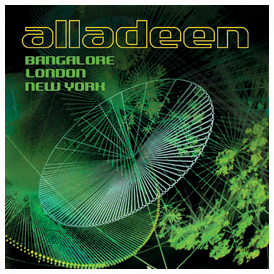


 |


Co-artistic directors Keith Kahn and Ali Zaidi formed London-based moti roti ("fat bread" in Hindi), a design-media-performance collective, in 1991 in an effort to move beyond the polarized East-West divide and to create work that addresses the complexities and contradictions of contemporary global culture. The Builders Association, formed in 1994 in New York City and led by director Marianne Weems, reanimates theater for a contemporary audience by using current tools to interpret old forms, exploring the interface between live performance and media.
Their collaboration resulted in Alladeen, a transglobal exploration of how cultures blur, steal from, and reconfigure one another's myths. With a script cowritten by transcultural travel writer Pico Iyer (The Global Soul) and novelist-journalist Martha Baer, Alladeen features a cast drawn from both companies. The artists are also creating parallel Web-based and music-video projects in an effort to reach audiences "where they live"--in clubs and public spaces, via television, and in heavily trafficked centers for fashion, media, and art. Inspired by early central Asian legends of Alladeen and his various incarnations around the world (for example, Aladdin in the West), Alladeen is a powerful model of cultural interaction, drawing on such influences as the ongoing exchange between Bollywood and Hollywood, the international technology trade, and the influx of Indian computer engineers in the United States. A combination of electronic music, cutting-edge video technology, architectural set design, and live performance, Alladeen resonates with the contemporary concerns of instant gratification, wish fulfillment, and rampant consumerism.
More on moti roti:
Set up in 1991 by Keith Khan and Ali Zaidi, moti roti is a London based, artist-led organization, celebrating diversity and pushing the boundaries of artistic and cultural discourse. The name moti roti, hindi/urdu words meaning "fat bread," is an ironic titling that has a resonance with those who recognize either the language or the food. Although the artists straddle three or more cultures (Trinidad, Pakistan, India), they are not interested in the polarized and mythical East/West divide, but more about making work which speaks to many different people about complexities and contradictions of the current times.
The company produces a range of innovative and inspiring yet accessible exhibitions, events, and experience-led installations, which is relevant both to specific communities and the wider public. moti roti combines visual seduction with a sensitivity to space and an eye for transformation. Its work has been seen in New and Old Walsall Museum and Art Gallery to the streets of Notting Hill, from the Dome to the Royal Albert Hall, from Brick Lane to Tate Modern in London.
More on The Builders Association:
The company's productions combine historic and new texts with performance, sound, video, and architectural sets to create a world onstage that reflects the contemporary culture surrounding us. Since 1994, with a growing circle of artists, The Builders Association has collaborated on seven large-scale theater projects, including Master Builder (1994), The White Album (1995), Imperial Motel (Faust) (1996), Jump Cut (Faust) (1997), Jet Lag (1998-1999), and Xtravaganza (2000.) The company has also created two installations. Most recently, it has toured to the Barbican Theater, London; Kaaitheater, Brussels; the Rotterdamse Schouwburg; Marstall Theater, Munich; Maison des Arts, Creteil/Paris; Sommerscene, Copenhagen; Trafo Theater, Budapest; The Kitchen, New York; The Guggenheim Museum, New York, and many other venues..
Related links:
http://www.motiroti.com/
http://www.thebuildersassociation.org/











